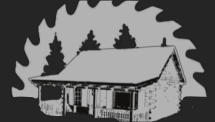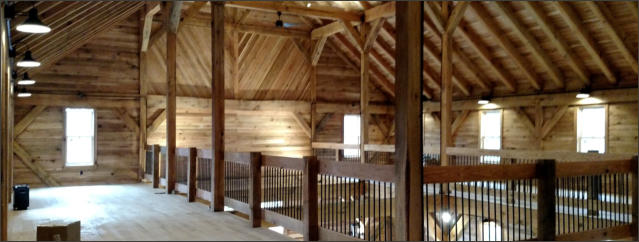







FAQ’S

•
What type of wood do you use in your log cabin kits? We use Oak for our logs
which are used for interior and exterior walls. Flooring can be Hickory, Ash, or
Oak. We do not provide treated lumber or plywood.
•
Do you design custom home kits? Yes we do, We will be happy to help you design
your custom Oak log cabin kit. Check our custom kits page.
•
How long does it take to build the log home kit? This depends on the size of the kit
and how many hands are involved. On average the 1200 sq ft Chalet takes 3 guys
about 3 weeks to get under a roof.
•
What type of foundation do you recommend? You can use any type of foundation
you choose- Basement, concrete slab or our pier system.
•
Is the roof included in the cabin kit? The roofing above the ship lap is not included.
We provide the rafters, ridge beam and ship lap ceiling.
•
What type of roof do you recommend? Most people prefer a metal roof, but shake
shingle or composite roofing material are used also.
•
How much does it typically cost to complete the log cabin kit? We usually suggest
the kit is half the cost of the completed cabin. So a $30k cabin can cost approx.
$55-65k to complete. Of course this depends on how much of the work you do
yourself and what type of fixtures, appliances, cabinetry, ect. you choose to use.
The sky is the limit if you want to spend the extra money.
•
Do you have a contractor you can recommend? We do not recommend
contractors. We suggest you contact your local realtor or building center for a list
of contractors. Angie's list or Craig's list are also places to look.
•
Do you finance? We do not finance at this time. Please check our tab in the main
menu for information about financing.
•
Do you know who will finance? Most banks will finance your building project.
Please check the main menu for info.
•
What type of insulation is used in the log home kit? The logs are their own
insulation. A chinking material and backer rod is used to seal between the logs.
The roof uses which ever type of insulation you choose.
•
What is the R value of An Oak log home? Logs actual R value is about one R value
per inch of log thickness. Our logs are about 6 ½ inches in thickness and they
would have an R value of between 6 and 7. However, logs have an additional
insulating ability based on their mass and weight, called thermal mass, which
greatly increases their insulating ability that is not used in the calculation of R
value. The insulating ability of a 5 ½ inch white oak log wall when considering the
inherent R value of the log and the thermal mass is about equal to a standard 2 x 4
insulated wall.
•
How will I get my cabin Kit? We ship all of our cabins via semi. Or the purchaser
can pick the cabin kit up at our mill facility.
•
Who is responsible for shipping? The freight is on the buyer. We will be happy to
assist you in arranging shipment of your cabin but the cost is the sole
responsibility of the purchaser of the cabin. Please contact us for shipping details
as prices can vary from region to region.
•
How many shipments will the kit come in? It depends on which kit you purchase
and any modifications that you make to the kit. But usually the small Hunting
cabin is 1 load, the rest of the kits are shipped in two loads except the largest kits
which require 3 semi loads.
•
A common question we get asked here at Schutt Log Homes and Mill Works is
“what about log shrinkage as the Oak logs dry?”.
•
Oak logs shrink there is no getting around that fact. When the Oak is selected and
handled properly the drying process is seen as giving character and quality to the
log home. As Oak dries it becomes much denser making it harder. Basically Oak
gets better with age. With proper chinking and sealing the log cabin will remain
insulated and water tight through the shrinking process.
•
When an Oak tree is sawn it has a very high moisture content (MC), sometimes up
to 80%, where a dry piece of timber inside a building can have a MC as low as 8%.
In the beginning as Oak dries it loses what is known as ‘free water’ from its cell
cavities. Once the ‘free water’ is evaporated the timber is said to have reached its
fiber saturation point (FSP). In Oak this is around 30% MC. Next the Oak will
begin to lose what is called “bound water”, this is the water contained in the cell
walls. When the bound water evaporates is when the shrinkage in the timber
begins.
•
An Oak log in a home can typically reach a MC of about 12% after several years.
The rate of the moisture loss will affect how much an Oak log will shrink. The
faster Oak loses its bound water in the cell walls the more it will shrink. Oak
contains longitudinal cells called vessels which are straw like. When these vessels
are allowed to dry very slowly in a stable manner shrinkage is drastically reduced.
•
Schutt Log Homes and Mill Works allows our Oak logs to dry naturally to keep the
drying process as slow as possible. When our logs are shipped the moisture
content will generally be between 20-25%. This will allow the logs to dry slowly
and naturally in their new environment.
•
Powder Post Beetles are a rare occurrence in Oak logs and lumber, however, on
occasion infestations do occur. It is impossible through the milling process to
determine if there are powder post larvae in the logs. Though we make every effort
to watch for mature beetles. The signs of powder post beetles are small holes in
the wood called “shot” holes because they look like gun shots and a very fine saw
dust almost like flour. If these signs are noticed treatment is inexpensive and
simple. The wood is best treated before it is stained or sealed.
•
The best treatment for a powder post beetle infestation is Borate. The two borate
formulations currently registered for residual surface treatment of wood are
Bora-Care(R) and Tim-Bor(R). Both formulations are virtually nontoxic, odorless,
and remain effective for as long as 40 years. Both products are available through
professional pest control operators. Customers wishing to perform the application
themselves can, with some effort, obtain Bora-Care and Tim-Bor through chemical
distributors and lumber companies.

Schutt Log Homes
& Mill Works






FAQ’s

•
What type of wood do you use in your log cabin kits? We use Oak for
our logs which are used for interior and exterior walls. Flooring can be
Hickory, Ash, or Oak. We do not provide treated lumber or plywood.
•
Do you design custom home kits? Yes we do, We will be happy to help
you design your custom Oak log cabin kit. Check our custom kits page.
•
How long does it take to build the log home kit? This depends on the
size of the kit and how many hands are involved. On average the 1200
sq ft Chalet takes 3 guys about 3 weeks to get under a roof.
•
What type of foundation do you recommend? You can use any type of
foundation you choose- Basement, concrete slab or our pier system.
•
Is the roof included in the cabin kit? The roofing above the ship lap is
not included. We provide the rafters, ridge beam and ship lap ceiling.
•
What type of roof do you recommend? Most people prefer a metal
roof, but shake shingle or composite roofing material are used also.
•
How much does it typically cost to complete the log cabin kit? We
usually suggest the kit is half the cost of the completed cabin. So a
$30k cabin can cost approx. $55-65k to complete. Of course this
depends on how much of the work you do yourself and what type of
fixtures, appliances, cabinetry, ect. you choose to use. The sky is the
limit if you want to spend the extra money.
•
Do you have a contractor you can recommend? We do not recommend
contractors. We suggest you contact your local realtor or building
center for a list of contractors. Angie's list or Craig's list are also places
to look.
•
Do you finance? We do not finance at this time. Please check our tab in
the main menu for information about financing.
•
Do you know who will finance? Most banks will finance your building
project. Please check the main menu for info.
•
What type of insulation is used in the log home kit? The logs are their
own insulation. A chinking material and backer rod is used to seal
between the logs. The roof uses which ever type of insulation you
choose.
•
What is the R value of An Oak log home? Logs actual R value is about
one R value per inch of log thickness. Our logs are about 6 ½ inches in
thickness and they would have an R value of between 6 and 7.
However, logs have an additional insulating ability based on their mass
and weight, called thermal mass, which greatly increases their
insulating ability that is not used in the calculation of R value. The
insulating ability of a 5 ½ inch white oak log wall when considering the
inherent R value of the log and the thermal mass is about equal to a
standard 2 x 4 insulated wall.
•
How will I get my cabin Kit? We ship all of our cabins via semi. Or the
purchaser can pick the cabin kit up at our mill facility.
•
Who is responsible for shipping? The freight is on the buyer. We will be
happy to assist you in arranging shipment of your cabin but the cost is
the sole responsibility of the purchaser of the cabin. Please contact us
for shipping details as prices can vary from region to region.
•
How many shipments will the kit come in? It depends on which kit you
purchase and any modifications that you make to the kit. But usually
the small Hunting cabin is 1 load, the rest of the kits are shipped in two
loads except the largest kits which require 3 semi loads.
•
A common question we get asked here at Schutt Log Homes and Mill
Works is “what about log shrinkage as the Oak logs dry?”.
•
Oak logs shrink there is no getting around that fact. When the Oak is
selected and handled properly the drying process is seen as giving
character and quality to the log home. As Oak dries it becomes much
denser making it harder. Basically Oak gets better with age. With
proper chinking and sealing the log cabin will remain insulated and
water tight through the shrinking process.
•
When an Oak tree is sawn it has a very high moisture content (MC),
sometimes up to 80%, where a dry piece of timber inside a building can
have a MC as low as 8%. In the beginning as Oak dries it loses what is
known as ‘free water’ from its cell cavities. Once the ‘free water’ is
evaporated the timber is said to have reached its fiber saturation point
(FSP). In Oak this is around 30% MC. Next the Oak will begin to lose
what is called “bound water”, this is the water contained in the cell
walls. When the bound water evaporates is when the shrinkage in the
timber begins.
•
An Oak log in a home can typically reach a MC of about 12% after
several years. The rate of the moisture loss will affect how much an
Oak log will shrink. The faster Oak loses its bound water in the cell
walls the more it will shrink. Oak contains longitudinal cells called
vessels which are straw like. When these vessels are allowed to dry
very slowly in a stable manner shrinkage is drastically reduced.
•
Schutt Log Homes and Mill Works allows our Oak logs to dry naturally
to keep the drying process as slow as possible. When our logs are
shipped the moisture content will generally be between 20-25%. This
will allow the logs to dry slowly and naturally in their new environment.
•
Powder Post Beetles are a rare occurrence in Oak logs and lumber,
however, on occasion infestations do occur. It is impossible through
the milling process to determine if there are powder post larvae in the
logs. Though we make every effort to watch for mature beetles. The
signs of powder post beetles are small holes in the wood called “shot”
holes because they look like gun shots and a very fine saw dust almost
like flour. If these signs are noticed treatment is inexpensive and
simple. The wood is best treated before it is stained or sealed.
•
The best treatment for a powder post beetle infestation is Borate. The
two borate formulations currently registered for residual surface
treatment of wood are Bora-Care(R) and Tim-Bor(R). Both formulations
are virtually nontoxic, odorless, and remain effective for as long as 40
years. Both products are available through professional pest control
operators. Customers wishing to perform the application themselves
can, with some effort, obtain Bora-Care and Tim-Bor through chemical
distributors and lumber companies.





